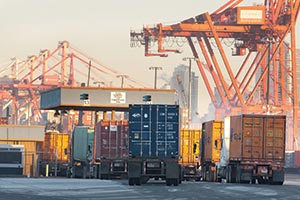Groups Praise Requirement For Port Efficiency Metrics

Industry groups generally welcomed a FAST Act provision that would require the U.S. Department of Transportation to create performance metrics to reduce delays at major ports, speed future cargo flow and prevent a recurrence of delays that plagued ports over the past year.
The little-noticed requirement takes up a single page, lurking inside the 1,317-page measure.
In the months leading up to signing of the law on Dec. 4, more than 100 groups pressed Sen. John Thune (R-S.D.), the Senate Commerce Committee chairman, to include the performance metrics favored in the bill, though there wasn’t a companion measure in the House version.
Backers included the National Retail Federation, individual ports and a variety of transport and manufacturing groups, including American Trucking Associations and the National Association of Manufacturers.
The law tasks DOT’s Bureau of Transportation Statistics with “a port performance statistics program to provide nationally consistent measures of performance,” including “specifications and data measurements” such as capacity and throughput as well as “a process for the department to collect timely and consistent data.”
Reports will be published annually for the 25 largest container ports.
BTS was directed to create a working group by early February to determine what data should be gathered and analyzed, since the law doesn’t specify what information should be gathered or set specific service quality targets, such as completing a truck move through port terminals in one hour. That is the standard recommended by the Harbor Trucking Association, the trade group representing Southern California truckers.
The statistics are “essential to addressing congestion issues at our nation’s ports,” the National Retail Federation stated after the $305 billion FAST Act cleared Congress. The federation specifically cited delays at West Coast ports in the months leading up to a tentative labor agreement in February.
During the summer, it and the other groups urging action told Congress that measuring port productivity “could help avoid a repeat of the congestion and slowdowns that occurred along the West Coast” as well as on the East Coast.
West Coast delays prior to the labor deal at times cut port productivity in half, or worse, according to the Pacific Maritime Association trade group, which represents terminal operators and ocean carriers.
PMA, however, took no position on the measure that was targeted at reducing those delays, its spokesman, Wade Gates, told Transport Topics on Dec. 9 without further explanation.
From the trucking standpoint, Curtis Whalen, executive director of ATA’s Intermodal Motor Carriers Conference, offered two perspectives:
“The fact that they are identifying problems is a good thing,” he told TT on Dec. 9. At least nine government groups, such as the Coast Guard and Federal Maritime Commission, will be in the working group under the FAST Act’s terms, compared with seven industry representatives from dock union, port authority, trucking, rail and the maritime sector.
Whalen compared the working group to the United Nations because of the broad spectrum of representatives, most of whom will come from government agencies.
However, Whalen said simply establishing a reporting system falls far short of fixing real-world problems. Delays have periodically escalated to as much as six hours spent in total waiting in line to enter a terminal or inside the facility to obtain the right chassis and container.
“The practical events that are happening have to be addressed, and the statistics [in the DOT’s statistical report] don’t address that. There is no sharing of information between terminal operators and chassis providers today. That’s needed to manage gate and terminal times, and it can’t work until those people make [the information] available to each other,” he said.
The American Association of Port Authorities, the trade group that represents those facilities, opposed the legislation when it specified government-driven port performance standards without industry input, instead favoring the working group approach that eventually prevailed in a House-Senate conference report.
Port officials at three of the nation’s five largest ports also backed the concept of reporting metrics.
Gene Seroka, executive director of the Port of Los Angeles, the nation’s largest, joined Jon Slangerup at No. 2 Long Beach, California, and Christopher Lytle at No. 5 Oakland, California, in urging a broad group to set those metrics.
At the same time, the three executives told congressional leaders that “the data you seek to collect is not available to landlord ports, but resides with the marine terminal operators. We recommend that responsibility for data collection reside with the entities best positioned to supply the information.”

